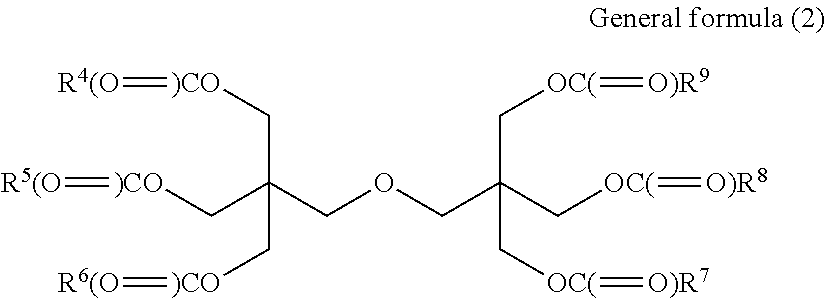Toner for developing electrostatic images
a technology toners, applied in the field of toners for developing electrostatic images, can solve the problems of reducing the heat-resistant shelf stability, and increasing the minimum fixing temperature, and achieves excellent heat-resistant shelf stability, low-temperature fixability, and high heat-offset resistan
- Summary
- Abstract
- Description
- Claims
- Application Information
AI Technical Summary
Benefits of technology
Problems solved by technology
Method used
Image
Examples
production example 1
[0135]To a four-neck flask provided with a thermometer, a nitrogen inlet, an agitator and a condenser, 312.9 g (1.1 mol) of stearic acid and 31 g (0.5 mol) of ethylene glycol were added and reacted for 15 hours at an ordinary pressure while distilling the reaction water at 180° C. under nitrogen flow. To thus obtained 100 parts esterified crude product, 20 parts toluene and 4 parts ethanol were added, and 10% aqueous solution of potassium hydroxide containing potassium hydroxide, the amount of which corresponding to 1.5 times the acid value of the esterified crude product, was further added. Then, the mixture was agitated for 30 minutes at 70° C. After the agitation, the resultant was left for 30 minutes, and a water phase (base layer) separated from the ester phase was removed, then the esterified crude product was washed with water. The water washing was repeated for 4 times until the pH of the water phase was 7. The solvent was distilled from the ester phase washed with water at ...
production example 2
[0138]Softening agent B (dipentaerythritol hexastearate) was obtained similarly as Production example 1 except that 31 g of ethylene glycol was changed to 43.2 g (0.17 mol) of dipentaerythritol. The acid value and hydroxyl group value of the obtained softening agent B were 0.1 mg KOH / g and 3.8 mg KOH / g, respectively.
[0139]The chemical structure of softening agent B is shown in the following formula (2B).
[0140]
production example 3
[0141]Softening agent C (1,4-butanediol distearate) was obtained similarly as Production example 1 except that 31 g of ethylene glycol was changed to 45.1 g (0.5 mol) of 1,4-butanediol. The acid value and hydroxyl group value of the obtained softening agent C were 0.1 mg KOH / g and 3.2 mg KOH / g, respectively.
[0142]The chemical structure of softening agent C is shown in the following formula (1C).
[0143]
PUM
 Login to View More
Login to View More Abstract
Description
Claims
Application Information
 Login to View More
Login to View More - R&D
- Intellectual Property
- Life Sciences
- Materials
- Tech Scout
- Unparalleled Data Quality
- Higher Quality Content
- 60% Fewer Hallucinations
Browse by: Latest US Patents, China's latest patents, Technical Efficacy Thesaurus, Application Domain, Technology Topic, Popular Technical Reports.
© 2025 PatSnap. All rights reserved.Legal|Privacy policy|Modern Slavery Act Transparency Statement|Sitemap|About US| Contact US: help@patsnap.com



